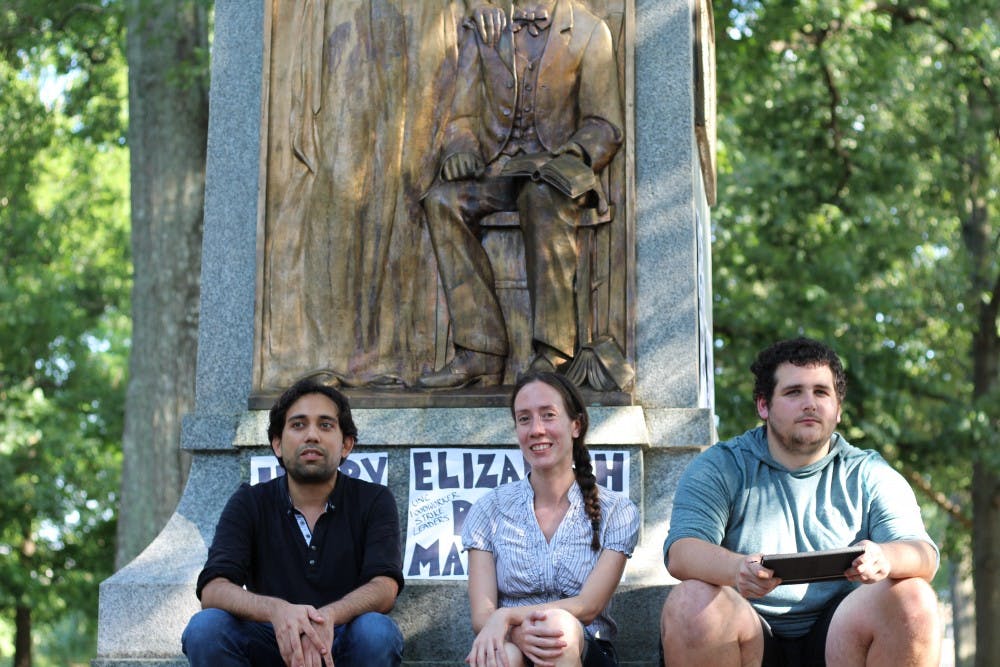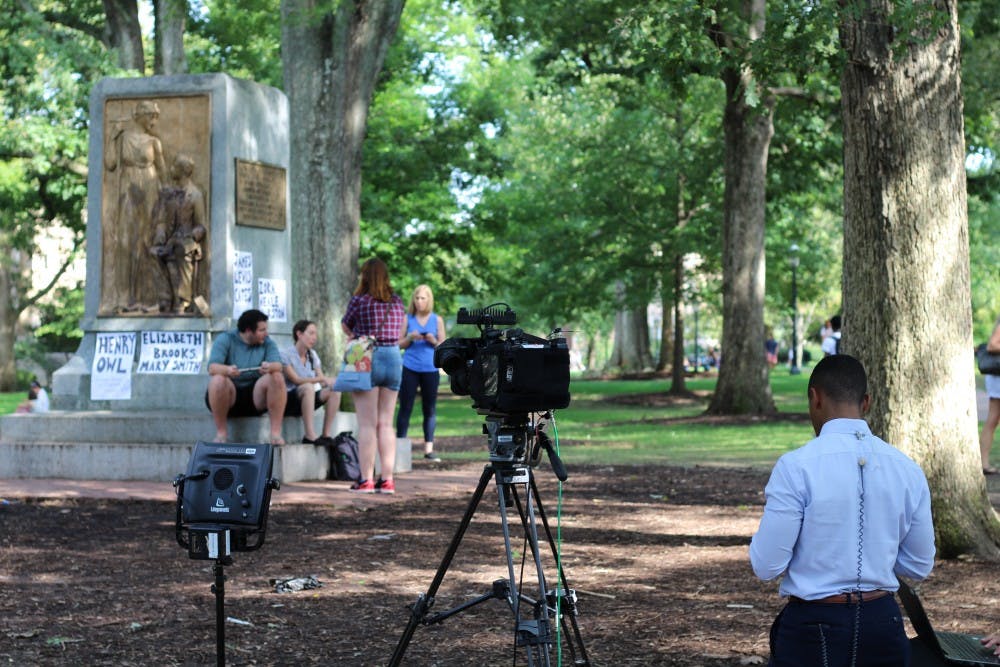CHAPEL HILL— Tim Osborne considered Silent Sam a plague that needed to be cured.
On Monday night, he saw his remedy first-hand.
Osborne, a 26-year-old graduate student at the University of North Carolina at Chapel Hill, was one of about 250 protesters who helped topple the controversial Confederate statue seated on campus. As he watched his peers pull the monument completely off its base to the dirt on a rainy night, Osborne said he felt hope.
It’s something he thinks can be replicated at similar sites across the state.
“This is an issue for all of North Carolina. It's an issue for pretty much all the country," he said.
"It's about the discussion of should we be memorializing these ideologies. Silent Sam was one of the best made statues in the state, and if this one can come down, they all can come down.”
Conflicting attitudes steamed over the statue for years, but tensions rose Monday night. People originally gathered in support of Maya Little, a UNC graduate student charged in April with vandalizing the statue with red paint and blood. But the gathering quickly turned into two sides with opposing views, including some from Alamance County.
Osborne said he was threatened at knifepoint by a member of Alamance County Taking Back Alamance County, a local “southern rights” group which the Southern Poverty Law Center has labeled as a “neo-Confederate hate group.”
Osborne said ACTBAC promised to return. So after his first day of fall semester classes Tuesday, Osborne sat at the pedestal of Silent Sam for hours to protect people looking at the statue's remains.
“The counter-protesters are threatening us with death, threatening to lynch Maya for painting the statue and threatening to come back with an arsenal and gun us down. When I'm sitting here, I think that what we did was the only justifiable action.”
ACTBAC could not be reached for comment after multiple attempts, but the organization said on Facebook that "WE ARE AT WAR," and that they plan to have a heavy presence at UNC in the coming weeks.
On Tuesday, UNC Chancellor Carol Folt, UNC Board of Governors Chairperson Harry Smith, UNC-system President Margaret Spellings and UNC Board of Trustees Chairperson Haywood Cochrane issued a joint statement saying the State Bureau of Investigation will assist local police in investigating the protests.

Decades of unrest boil over
North Carolina has endured similar controversies for more than a century. Over 130,000 North Carolinians fought for the confederate cause in the Civil War, and at least 95 monuments immortalizing their contributions are placed throughout the state, according to the Charlotte Observer. On Wednesday, a state commission voted to not remove three of those statues on the State Capitol grounds in Raleigh.
Silent Sam was originally erected in 1913 as a monument to the university’s students that left school to serve in the Confederate army. Protests against the statue first arose in the 1960s, during the civil rights movement, but have returned with a renewed vigor since a white supremacist in Charlottesville, Va. brought the debate over Confederate Statues into the national spotlight in 2017.
According to Kate Karstens, who has followed the Silent Sam story closely as assistant university desk editor for The Daily Tar Heel, the controversy’s persistence on campus is partially due to the area’s unique history and current demographic makeup.
“The demographics here play the biggest role in how these statues are perceived,” Karstens said. “If you have a statue on campus that signifies a support or remembrance for a side of a national conflict that is still ever-present in your community and has a lot more people that are going to be offended by that monument, you’re going to have a lot more pushback.”
Protesters oppose both the monument’s origins as well as the university’s continued support of its presence. In a speech christening the statue over a century ago, a local white supremacist bragged about whipping a black woman and praised Silent Sam as a testament to “the welfare of the Anglo-Saxon race.”
In more recent years, those asking for the statue’s removal have alleged that school officials assume a sympathetic stance to conservative donors who would prefer Silent Sam remain standing.
“It was very clear that the Republican Board of Governors and rich donors in particular were incredibly powerful in shaping the decision making of the Chancellor,” said Samee Siddiqui, a doctoral student at UNC. “The Chancellor talked about how she was sympathetic to the protesters but did not meet them, did nothing but give sort of lip service to the idea that she was pro-racial-equality.”
Siddiqi referenced Folt, who, in the face of calls for the statue’s removal, has referenced a commitment to upholding a 2015 state law that prevents the removal of historical monuments. The University has also reporteldy spent $390,000 protecting the statue over the past year.
Alamance County connections run deep
In the past, ACTBAC has been vocal on conserving Confederate memorabilia.The group has also hosted rallies touting Confederate pride, such as Confederate Memorial Day in May. Gary Williamson, president and founder of ACTBAC, also vouched for preserving the Confederate statue in front of the Alamance County Civil Courthouse in Graham after the events in Charlottesville.

Confederate supporters listen to Gary Williamson (far left), the founder and president of ACTBAC, speak at the Confederate Memorial Day Service May 10 at the Alamance County District Judge building.
Amy Scott Galey, chair of the Alamance County Board of Commissioners, said she is unsure whether the county will allocate more security to the Confederate monument in front of the court house. The sheriff's office did not respond to a request for comment. But she did say that they would take vandalism seriously.
“As county government, we don't have a stance on the statue,” she said. “But we support law and order, and anyone who resorts to vandalism will be prosecuted to the full extent of the law.”
Osborne said though seeing Silent Sam gone was a great sight, he knows its not the end of the controversy. With ACTBAC's threats to come back stronger, he knows the ongoing controversy will continue.
But Monday night's events were the start of curing the plague for good, he said.
"This is a nationwide movement of showing what can be done in the face of problems," he said. "It just establishes this nationwide framework coalition of people that are working together to really make change."


